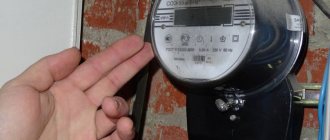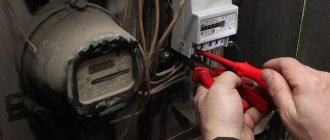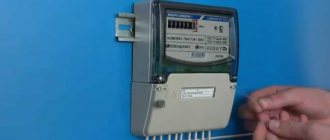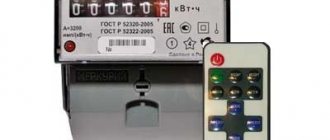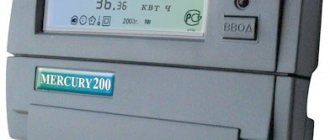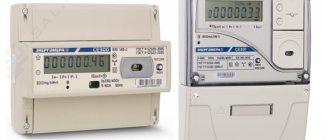Many owners of cottages, dachas and apartments in multi-storey buildings face the need to solve this problem. An electricity meter or electric meter is a device for monitoring the consumption of electrical energy. It is necessary for electricity suppliers to issue invoices for electricity consumption to both the population and various industrial enterprises and other organizations. Currently, there are two types of electricity meters.
- Induction. The operating principle of these electromechanical devices is based on the laws of physics: a metal disk rotates in an inductive electromagnetic field, which creates a flowing electric current. The disk axis, through a transmission unit, is connected to a mechanical meter, which indicates how much electricity was consumed in kilowatt/hours.
- Electronic. Modern devices equipped with voltage and current sensors, converters, microcontrollers, displays and other electronic modules. The principle of their operation is as follows: analog signals from sensors are converted into a digital code, which is decrypted by a microprocessor, and the amount of electricity consumed is displayed on the display.
Regardless of the type of electricity meter, these devices do not last forever! What to do if the electricity meter breaks down and where to go in that case? In this article you will find answers to these questions, and we will start with a description of malfunctions of electricity meters.
Attention! Do not attempt to troubleshoot or replace the electric meter yourself. Unauthorized damage to the seals on this device may result in a large fine. If the meter fails, you must contact the energy supply or electrical network service company!
Types of electric meter faults
The reasons for the failure of electrical energy metering devices can be very different: damage due to mechanical stress, overload, network instability, and so on. It is quite easy to determine that the electricity meter is broken; just inspect the device and the breakdown will be identified.
1. The electric energy meter has burned out. The body of the device and contacts are melted, there is a burning smell. Electrical wires connected to the electric meter burned out. In this case, the device cannot be repaired and must be completely replaced.
2. Damage to parts of the electric meter housing as a result of mechanical impact. There are through cracks, various dents and chips on the body or sight glass. The device as a whole or its individual parts must be replaced.
3. The contact pads of the device burned as a result of overheating. This type of failure occurs due to weakening of the contacts between the input and output circuits of the network. The malfunction is eliminated without removing and replacing the electric meter with a new device.
4. The counter is heavily overloaded. There was a humming sound (for induction devices), the smell of burnt insulation and clouding of the sight glass. The electricity meter should be replaced with another device corresponding to the increased power consumption.
5. The electricity meter continues to indicate electricity consumption when the load is off or stops working completely. This malfunction indicates damage to the internal parts and circuits of the meter. The device must be repaired or replaced with a new one.
All these faults are obvious. In addition to these, there are a number of reasons why it is necessary to change the electric meter to a new device. These include the following established facts:
- the meter has an accuracy class greater than 2.5, with the established norm not exceeding 2.0;
- The device has completely reached its normal service life.
Important! An electric meter on which the seals have been broken is considered faulty, even if it is working normally. In this case, operation of the device is prohibited! For this type of violation, a warning or a fine of 100 to 300 rubles is provided, in the absence of other violations of the operation of metering devices.
In some cases, there are no external signs of a malfunction in the electricity meter, but the consumer has doubts about the correctness of the device’s readings. You can check the correct operation of the electric meter yourself.
Types of electricity control control checks
There are two types of meter checks: primary and periodic. The metering device undergoes initial verification at the manufacturer before installation and use for its intended purpose.
Periodic inspection is carried out until the end of the prescribed revision interval. An extraordinary check of the electricity meter may also be scheduled. It is carried out if:
- there is no document confirming the periodic inspection;
- there is a confirmed need to configure such a counter;
- There was a need to install a new meter.
Inspection intervals may vary for different types of instruments. Also, the frequency of the audit may be affected by various emergency situations.
Electricity metering can only be carried out using a meter that has a product passport or a certificate confirming its compliance with current standards.
Carrying out inspections of metering devices is the responsibility of special organizations. You can call a specialist from such an organization to your home. If this option does not seem reliable enough to you, take the meter to a special organization. After checking the measuring device, you will be given an inspection report.
What the RA needs to know about the installation of common house metering devices
180474
Checking the correctness of meter readings
To perform this procedure, you must turn off all household electrical appliances and lighting equipment. Make sure that the disk of the induction meter has stopped, and if an electronic device is installed, the readings on the display are frozen at one value. The further verification algorithm consists of the following sequential actions.
- It is necessary to plug in a load into the home network socket: a 100 W light bulb for exactly five minutes. In this case, the calculated consumption value should be: P1 = 5×0.1/60 = 0.0083 kW/hour. If you have an induction meter, then count the number of disk revolutions during this time. With an electronic meter everything is simpler - just take the initial and final readings on the display. The difference between them will be the amount of electricity consumed during five minutes of operation of a 100-watt lamp.
- Calculate the amount of electricity consumed recorded by the meter. For an induction device, it is calculated by the formula P2 = Rh × N, where N is the number of disk revolutions in five minutes, and Rh is the electricity consumption per one disk revolution, which is determined based on the information on the front panel of the electric meter. Metering devices have a certain error. If this value is greater than the difference between P1 and P2, then the electrical energy meter is working correctly.
All of the above options for electric meter malfunctions must be eliminated by repairing the device or completely replacing it. But the question of how to do this remains open! In the next part of the article we will tell you what to do if the electricity meter burns out or breaks down and which organization to contact about this.
Where to install
When installing the meter outside, the following technical requirements must be observed:
- usually, if there are requirements from the provider company, the device is installed on the facade of the house at a height of 70 cm to 170 cm for ease of maintenance;
- It is also practiced to install the meter at the appropriate height on a concrete pole, while it must be located on the territory of the house, and the wiring is installed in the house itself.
The question of whether the requirement to move meters outside is legal is controversial. In fact, there are no regulations regulating the location of the meter.
The energy sales company motivates this by the fact that there should be easy access to the device for control purposes. However, in this case, no one is stopping them from installing a modern electronic device with a remote monitoring function in their home at their own expense and monitoring it at their own pleasure.
At the very least, these requirements are to the detriment of home owners and create inconvenience for them:
- When placed outside, the service life of the meter will be significantly reduced, since this device is not designed to operate in extreme conditions, in the rain, in frost, in heat. At low temperatures, readings may be incorrect.
- When installed on the street, the homeowner will have to put up with the fact that his meter has access not only to company employees, but also to everyone.
- Sometimes, to protect the instruments, they are installed at a height of 3 meters, which, to some extent, protects them from thieves, but the homeowner himself, without a ladder, will not be able to see his readings.
In fact, by forcing citizens to install meters on the street, they are deprived of the right to take care of the safety of their property, as provided for in the Civil Code of the Russian Federation.
This is beneficial for energy companies, as having the instruments outside makes it much easier for them to inspect and test the instruments, as well as take readings of energy consumption.
But this is the external side of the problem, and the flip side is that it will be possible to control not only the readings of the device, but also the connection to the network up to the meter. That is, ultimately, to solve their pressing problems at the expense of homeowners, and on a massive scale.
You may be interested in an article about installing a two-tariff electricity meter.
Read the article on the procedure for calculating electricity consumption standards without a meter here.
Who has the right to repair or change electricity meters?
The answer to this question is clear! Only employees of a specialized organization that has the right to carry out such work: a management company, an electricity supplier and an emergency service that maintains electrical networks. What to do if you have established for sure that the electrical energy meter is faulty? The main thing is not to panic! Find your electricity receipt. It must include contact numbers for emergency calls. You can also call the customer service department of your management company and they will send an electrician on duty to you.
Everything is quite simple, but it must be done quickly. If there is light in the house, but the meter does not record electricity consumption, there is a temptation to take advantage of free electricity. Do not do that! You can run into a large fine for theft of electrical energy. You need it? So, you called a specialist from the management or other company that services home electrical networks. The algorithm of actions for the electrician and yours personally will be as follows.
- The arriving specialist inspects the metering device, determines the malfunction and, if possible, eliminates it on site or installs a new device. In municipal housing, the meter is installed free of charge. Otherwise, you purchase an electricity meter at your own expense. If the electric meter is subject to repair, but it is impossible to carry it out on site, it is removed and transferred to an energy sales laboratory or another company that has the right to carry out such work. After the repair work is completed, the meter is installed in its original place.
- After performing all of the above manipulations, the electrician is required to draw up a report describing the nature of the breakdown and the appearance of the meter. Please read this document carefully. You never know what will be written there, you will have to pay for everything! Especially pay attention to the fact that the drawn up report clearly states that the seals are not damaged and there are no signs of the device being tampered with. This will save you from being charged with electricity theft. The drawn up report is submitted to the energy supply and management companies to properly record the results of repairs or replacement of the electricity meter.
- If the electric meter is replaced with a new device, it must be sealed. This operation is performed by an authorized employee of the management company or electricity supplier. Until the seals are installed, the electricity meter is considered not to be put into operation and payment for consumed electricity is carried out according to the standards approved by the Government of the Russian Federation. The act of installing seals on the electric meter indicates the date of the work, based on which the next deadline for state verification of the electricity meter is determined according to the established regulations.
We examined in detail the question of what to do if the electricity meter burns out. We only have to consider one nuance, namely: how to pay for electricity during the period of repair or replacement of the electric meter? Everything is simple here! During the first three months, payment is made based on average monthly electricity consumption for the last year. After this period, electricity charges are calculated according to special standards. True, it should be said that a three-month period is enough to carry out repairs and verification of a failed meter, and it is quite possible to replace and seal the meter in 3 days!
Rules for installing an electricity meter
- Installation of an electric meter in a private house should ensure that it is impossible to connect the consumer to the place of its installation. That is, to cut off the possibility of theft of electric current. And it doesn’t matter whether the device is being transferred or replaced with a new one.
- Installation of an electric meter in a private house must be carried out in a special panel or cabinet, into which other electrical devices can also be installed.
- The approach to the electrical panel must be free and convenient, and the panel itself must be installed smoothly without distortions.
- Mounting height – 0.8-1.7 m. Mounting below 0.8 m is allowed, but not below 0.4 m.
- Before installation, you must make sure that the next check in the state standard has not expired. To do this, you need to check the date of the last inspection or the date of manufacture of the device. For single-phase electricity meters the period is one year, for three-phase meters it is two years.
As an addition to these rules, there is one wish. The release to the meter should be installed no further than 10 m. This is in case you have to remove the metering and control device and check it. In this case, the release will simply de-energize the private house. However, it should be noted that the release, like the electric meter itself, will have to be installed in a sealed panel, which is sealed and locked. There is only one goal - to ensure the impossibility of unauthorized connection.
Grounds and reasons for replacing electricity meters
Among the reasons for replacing an individual energy metering device are the following:
- The consumer has an outdated model meter installed. The technical characteristics of the device must comply with established rules. So, the meter must be designed for a certain current strength, taking into account more powerful consumer devices. It must also have an accuracy class of at least 2.0;
- The device has expired. He is 16 years old;
- the device inspection period has been exceeded more than once;
- The device has serious defects in the case, for example, the screen is broken, there are cracks, chips. Normal scratches and abrasions do not warrant replacement.
- the electric meter shows signs of tampering, there is no seal, and any interference with its operation has been detected;
- the device is faulty;
- employees of the service provider issued an order to replace the electric meter. This may occur due to the fact that malfunctions have been detected, deviations from the established operating mode;
- when switching to multi-tariff metering of utility consumption (two-tariff or three-tariff). To do this, you need to install a device of a different model;
- subject to the owner's wishes.
Regardless of the reason, the meter must be changed in accordance with the procedure established by law. The owner of the home, even if he purchased the device at his own expense, does not have the right to independently take readings from the old device and seal the new one.
Types of installed energy meters
Modern devices for individual metering of electricity consumption can be classified according to the following characteristics:
- according to the type of current consumed. It can be constant or variable;
- by number of phases. According to this parameter, the meter can be single-phase or three-phase;
- according to tariffs. The electricity meter can be single-tariff, in which case a single cost per kilowatt is used in the calculation, or multi-tariff, when the cost per kilowatt depends on the time of day. In the second case, the device can be two-tariff (day/night) or three-tariff (the day is divided into three periods), for each interval its own payment is established;
- by type of mechanism. Depending on this parameter, the counter can be mechanical or electronic.
Electronic meters are the most common because they are easy to use. GOST on them is constantly updated, so purchasing such a device is not difficult. Mechanical counters are still used, but are gradually being replaced by more modern models.
Installing a meter for several tariffs is not available in all regions of the country.
Legislative basis for replacing electricity meters
In the field of legislation regulating the procedure for replacing electric meters, the following regulations are made up:
- Housing Code of the Russian Federation;
- Civil Code of the Russian Federation;
- Federal Law No. 261-FZ of November 23, 2009;
- Federal Law No. 102-FZ of June 26, 2008;
- Decree of the Government of the Russian Federation dated September 27, 2012;
- GOST 6570-96;
- State Register of SI (Unified State Register of Measuring Instruments).
The procedure for dismantling used measuring instruments and installing new ones must be carried out in accordance with these regulations.

